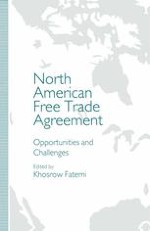1993 | OriginalPaper | Buchkapitel
Mexican EPZs as an Indicator of the Future Outlines of a NAFTA: The Case of Sonora
verfasst von : Lawrence W. Nowicki
Erschienen in: North American Free Trade Agreement
Verlag: Palgrave Macmillan UK
Enthalten in: Professional Book Archive
Aktivieren Sie unsere intelligente Suche, um passende Fachinhalte oder Patente zu finden.
Wählen Sie Textabschnitte aus um mit Künstlicher Intelligenz passenden Patente zu finden. powered by
Markieren Sie Textabschnitte, um KI-gestützt weitere passende Inhalte zu finden. powered by
Export processing zones (EPZs) have a dual nature: they are both an administrative instrument for providing free-trade status to a nation’s manufactured exports as well as industrial parks specialized in manufacturing for export (World Bank, 1992). In the absence of an economy-wide, ‘market-friendly’ (World Bank, 1991) environment for growth — a favorable entrepreneurial climate, macroeconomic stability, extensive external links and broad state support for human capital and infrastructure — EPZs have been employed with varying success by less developed countries (LDCs), including several of the most protectionist, inward-oriented ones, as a selective policy tool in their attempts to earn foreign exchange, increase employment and ultimately induce industrialization. The use of EPZs to shift to a more open, competitive, free-trade strategy for growth and domestic development has been characterized as a ‘post-Listian’ breakthrough to the extent that it represents a radical departure from the restrictive strategy of import-substitution industrialization (ILO/UNCTC, 1988, p. 155). Perhaps the term ‘anti-Listian’ might be more appropriate to describe the 180-degree policy shift that the EPZ-assisted open border strategy of industrialization can represent.
